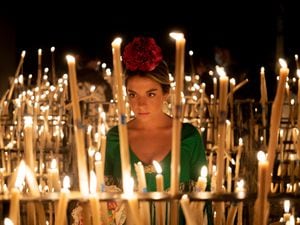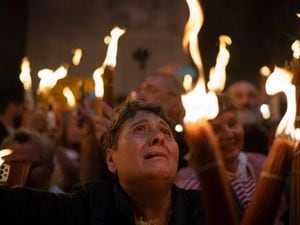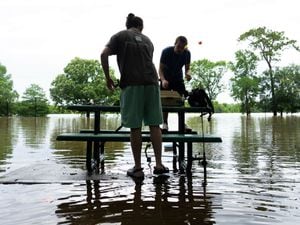Spain’s Rocio pilgrimage party returns after Covid hiatus
Tens of thousands of pilgrims, many of them outfitted in tiered flamenco dresses, crisp riding suits and wide-brimmed Cordoba hats, took part.

The riotously colourful and ancient La Romeria del Rocio – or the Rocio virgin pilgrimage – has returned to Spain after a two-year hiatus forced by the pandemic.
Tens of thousands of pilgrims, many of them outfitted in tiered flamenco dresses, crisp riding suits and wide-brimmed Cordoba hats, descended on the tiny village of El Rocio to take part.
For several days, droves of people — entire families or groups of friends — wind their way across different country paths and roads, many of them on foot while others go by horse or in elaborately decorated horse-drawn wagons or caravans, kicking up clouds of dust in the sun-baked countryside of southern Andalucia as they go.
The pilgrimage, organised by dozens of “brotherhoods”, is a veritable explosion of colour and revelry.

A heady mix of religion and raucous celebration, the style of dress, food, drink and song are as much a part of the festival as devotion to the virgin.
The pilgrims eat out in the countryside and often camp out there, too.
The pilgrimage attracts young and old, and the pervading feeling this year was one of joy at being able to once again celebrate a pilgrimage that is iconic to Andalusian culture.
“The Rocio is something that cannot be explained. You have to come here and feel it,” said 15-year-old Antonio Carlos Martín Duque, who rode a horse.

Antonio Molina Sanchez, 47, from nearby Huelva, described his family’s delight in making the pilgrimage after two years of cancellations.
“For a family like ours that live for it — a ‘Rociera’ family — it’s joy.”
Even so, the shadow of the Covid virus lingered. “We are afraid; we have masks in our pockets (but) often the emotions do not let you think, and you go into the crowds without realising it,” he said.
“We hope that with three vaccines, and the protection of the virgin, we’ll be safe.”

After several days of travelling, the pilgrims converge on the tiny, white-washed hamlet of El Rocio, whose name means morning dew and whose only reason for existing is the sanctuary of the virgin.
There, on the eve of each Whit or Pentecost Monday, they take a huge ornate float carrying the effigy of the virgin known as the Blanca Paloma (white dove) and parade it around the town, visiting the main brotherhoods at each of their grand meeting places that line the entrance into the town.
Thousands of people pack the boulevards to take in the procession along with its sideline competitions and spontaneous parties.
This year’s procession was cut short by several hours after the float developed a structural problem, forcing officials to bring back the virgin to its chapel, or shrine.
The roots of the Romeria del Rocio pilgrimage stretch back centuries when, as the legend has it, a statue of the Virgin Mary was stumbled upon in a hollowed-out tree trunk near the town of Almonte, which the village of Rocio belongs to.






